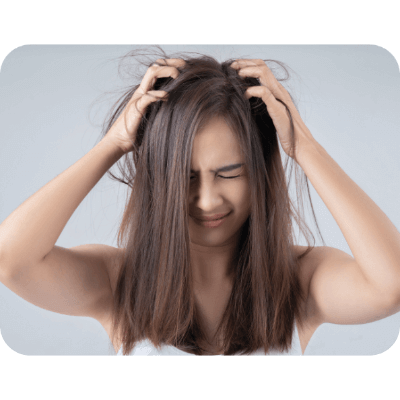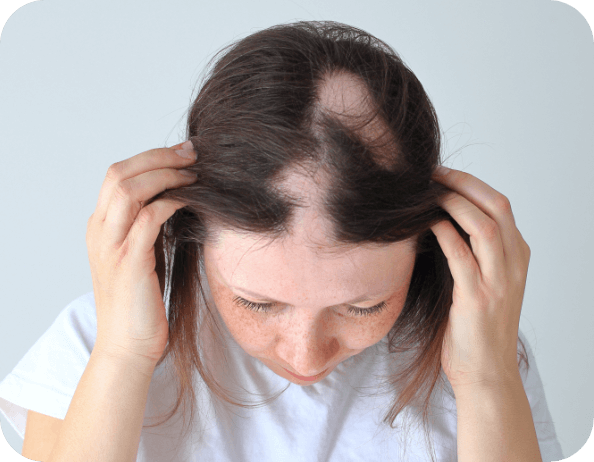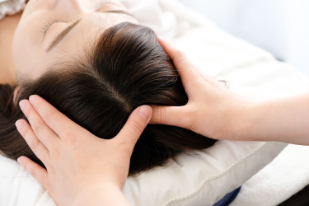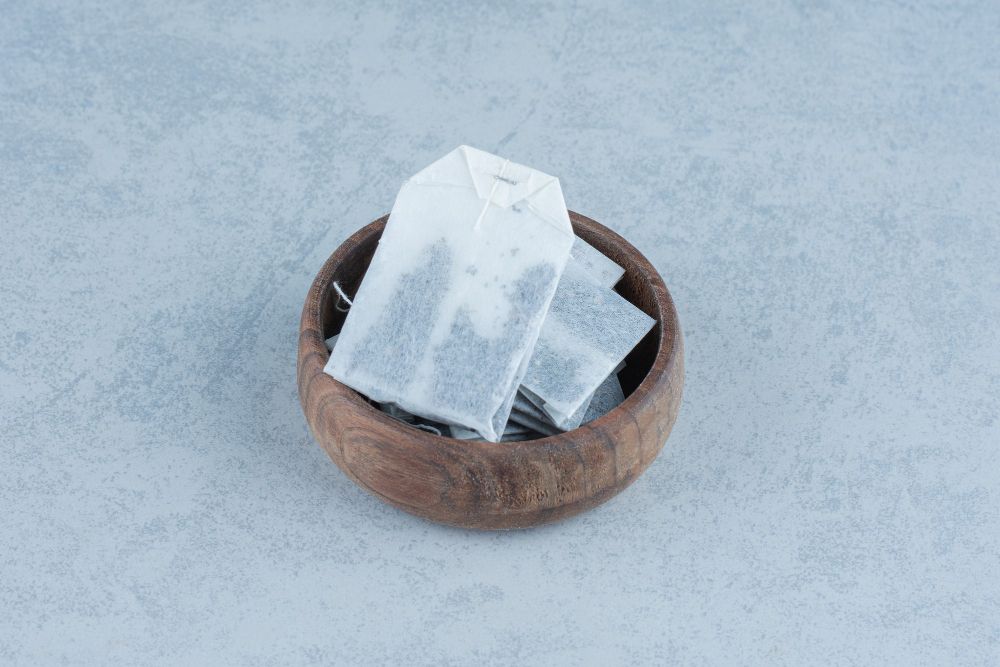

Book Now to Experience
F8 Hair Regrowth Treatment
1 Minute Self-Registration
Date should not be before minimal date
Author: Puteri Fikri|Updated: 23 July 2024
As much as we see the common hair loss in men, it is the same for women too. It is estimated about 50% of women will experience noticeable hair loss. Though women may be more expert in hiding them as having thin hair can affect self esteem. Female hair loss can be affected by various reasons despite their age.

1
Hair growth processes that you should know

Basically hair growth consists of three phases which are anagen, catagen and telogen phase. If these three phases went smoothly, the balance of your hair production would be great. However in most hair loss problems, the hair can not last long during these three phases.
In general anagen phase should have occurred around two to eight years for your hair. For your shorter hair like eyelashes or arm and leg hair, the anagen phase would be much shorter which is around one month.
Several types of hair loss for women includes :
Anagen effluvium - which is caused by medications that will affect the growing hair follicles. This is very common in cancer treatment. In this disorder, anagen hairs suffer from toxic or chemical insult which results in the fracture of the hair shaft.
Telogen effluvium - this is caused by an increased number of hair follicles reaching the telogen phase which is the stage where hair falls out. These hair falls occur due to drugs, trauma, emotional or extreme physical stress.
Type of hair loss that women tend to face
Although hair loss is more popular in men, it is actually quite common for the ladies. Though the cause could be different according to gender, the symptoms are hair thinning and you lose your hair more than you regrow new hair.
Several types of hair loss for women includes :
Anagen effluvium - which is caused by medications that will affect the growing hair follicles. This is very common in cancer treatment. In this disorder, anagen hairs suffer from toxic or chemical insult which results in the fracture of the hair shaft. Telogen effluvium - this is caused by an increased number of hair follicles reaching the telogen phase which is the stage where hair falls out. These hair falls occur due to drugs, trauma, emotional or extreme physical stress.
Androgenetic alopecia or female pattern hair loss (FPHL) - this is the most common for females in which thinning hair occurs over the top of the head and on the sides. This is quite different from male pattern baldness which for women, they do not experience receding hairline. Other symptoms that can be seen for someone who experience female pattern baldness is that their scalp skin is not healthy which causes the hair to be dull and brittle. Eventually she will continue to lost hair as they are not being supplied with nutrition.


2
Type of pattern that could be seen for women's hair loss

Female pattern hair loss that results in baldness is the most common type of hair loss in women. The pattern that can be seen is that the hair starts to thin mainly on the top and crown of the scalp. It usually starts with a widening through the center hair part. Hair loss rarely progresses to complete baldness as that is more common in man.
Female pattern hair loss
Basically professionals divide female pattern hair loss into 3 types which starts with a gradual thinning at your hair parts. Then, the parts will widen and increase thinning around it. The thinning will be throughout with a see through at the top of the scalp. It is seldom to see women with partial or complete baldness that occur from normal hair loss.
Is it just male or female who will also undergo this hair fall issue?
Female pattern baldness can be naturally occurring, related to genetics or side effects of medical treatments. It is quite common for older women over 40 years old to be experiencing hair loss. New moms also could experience excessive hair shedding after pregnancy. Hair shedding usually goes through the roof about four months after giving birth. Having high blood pressure could also lead to your hair sheds. New moms will undergo noticeable hair loss which is caused by falling estrogen levels. The bright side for dear mummies is that this situation is temporary and most women will see their hair return to its normal fullness by the child's first birthday. There are times where they will regain their original hair condition even earlier.
Can hair loss be a hereditary factor?
Your proclivity to hair loss could be genetic which means it is passed down for generations. Family history can be the reason for female hair loss. Hereditary hair loss can be a worrying factor especially if you do not have an early treatment for this. Anagen effluvium can be a common factor for hair loss in women Women who undergo anagen effluvium type of hair loss is often associated with the one who consumes toxic substances. As scary as it sounds, the toxic substances usually come from medication that is needed for cancer. Women who have cancer will need to undergo chemotherapy and have to take other medications. Usually this treatment will lead to hair loss all over your body - not just on the scalp. Hair usually begins to fall out two to four weeks after the treatment starts. The hair loss will continue throughout the treatment and up to a few weeks after that.
Alopecia areata, a condition that you need to be worried of?
Alopecia areata; a medical term for bald spots and patchy hair loss can be developed anywhere on the body including the scalp, beard area, eyebrows and armpits. The person with this condition will experience hair loss at an unpredictable rate. The hair may regrow without treatment. However, they will remain healthy despite having this issue. As women tend to have different hairstyles more frequently than men, they are at a larger risk of having brittle hair. Women who often have their hairstyles into tight buns, ponytails or braids could lead to hair loss too. In fact, there is actually a medical term to this type of hair loss in women which is traction alopecia. Traction alopecia can be a temporary hair loss situation if you can change your habit of treating your hair.
Telogen effluvium, a common condition for all woman at any age
Another type of hair loss in women is telogen effluvium. This is caused by extreme physical stress or shock to the body. However, it is a temporary hair loss which is usually caused by losing a lot of weight, weight gain, surgery, anaemia or giving birth. Women who face hormone changes caused by pregnancy, menopause or birth control pills are most likely to face this type of hair loss.

3
Dos and don'ts to help with your hair loss

Basically you can follow a few simple steps to avoid this type of hair loss such as avoid frequently wearing hairstyles that pull back on your hair. Let your hair down and not be in distress all day. Hair styling practices that involve intense heat should be avoided. The continuous pulling will damage your hair follicles and your hair can not grow back.
What is the relationship between hair loss in women and menopause?
Menopausal women will undergo the experience of their estrogen and progesterone levels to fall which means the male hormones to be increased. During the menopausal period, you may be facing thinner or missing hair because hair follicles shrink. Hair growth becomes slower and falls out easily in these cases.
What should you do if you start to lose hair?
If you start worrying about the amount of hair loss that you are facing, you may undergo a few tests to diagnose the root cause and treatment needed. If your situation is not having permanent hair loss, then there is still hope of growing new hair. First, the most common test can be done by gently pulling on your hair and seeing how much hair comes out.
Blood tests, is it really necessary to diagnose hair loss
Next, the most crucial test that any doctor would suggest before starting your hair treatment is blood tests. This is because to rule out if you are having any disease that could lead to hair loss. Then other nutrients can be checked like vitamin and mineral levels (Vitamin B, Vitamin D and Zinc) . Other factors that will be checked are thyroid disease and sex hormones. To treat female baldness should come with professional examination and diagnosis. Most medical practices that offer hair treatment will be equipped with scalp examination as they would like to have a thorough examination under a microscope.
What products can you keep your eye on to treat hair loss?
Certain products or ingredients can help to slow down or stimulate hair growth. Currently the main ingredients that are approved for hair regrowth are minoxidil and finasteride. Minoxidil works by partially enlarging the hair follicles and lengthening the hair growth's process. Meanwhile finasteride works by decreasing the amount of hormone dihydrotesterone (DHT) in the body. Dihydrotesterone is an androgen which is a sex hormone that contributes to the development of "male" sex characteristics such as body hair. This gives the result of further hair loss.
Hair regrowth techniques that you could do it yourself
Keep your hair follicles healthy and avoid any blockage To grow more hair, you need to put in as much as you give to your skin. To start the process at home, you can pamper your scalp by massaging them with hair oils and masks. A study shows that scalp massaging improves hair growth, blood flow and scalp health. By having some me time during this massage, you could also elevate your stress and tension which indirectly gives an impact to your hair growth. Always remember to avoid nails during the massage and start with circling across your scalp.


4
Aloe vera and coconut oil can help you to have a better scalp

It has been for generations that aloe vera has been used to treat hair loss. Aloe vera helps to soothe the scalp and condition hair. It can also help to reduce dandruff and unblock hair follicles that have been full with excess oil. Aside from aloe vera, coconut oil can contain fatty acids which if penetrated inside the hair shaft can significantly reduce hair loss.
Are there any supplements that can be taken to have a fuller hair?
To consume supplements, you must get to know your body well and if you are certain, then you can get your hands on viviscal. A natural hair growth supplement which contains a marine complex known as AminoMar C, a mineral rich combination of shark and mollusk powder, organic silica and vitamin C. These ingredients can help regenerate new cells and strengthen existing cells.
Fish oil and ginseng, natural ingredients that will give you all the benefits
Another natural resource that you can consume are fish oil and ginseng. Fish oils contain fatty acids that can help to grow hair since it is filled with nutrients and proteins. Taking omega supplements along with antioxidants will improve your hair density. Meanwhile ginseng can help to stimulate hair follicles as it contains ginsenosides. Be aware of keeping a healthy diet in your tab as well to provide other nutrients for your hair.
Rosemary oil; a secret life savior for hair loss?
It has been a viral trend on tiktok for rosemary oil to promote hair growth and reduce hair loss. Rosemary oil can even be used to treat androgenetic alopecia. Mix a few drops of rosemary oil with argan or jojoba oil and massage into your hair and scalp. You can repeat this process a few times a week. You can also add rosemary oil into your shampoo and conditioner.

Book Now to Experience
F8 Hair Regrowth Treatment
1 Minute Self-Registration
Date should not be before minimal date

5
Professional hair loss treatment that you can seek to

Hair transplant surgery
Aside from consuming medication, the common type of hair treatment that many have opted to choose is hair transplant surgery. During a hair transplants procedure, the surgeon will remove hair from a part of the head and transplants it to bald spots. The procedure does not require hospitalization however it is painful and you will be given sedation medicine to ease the discomfort. Possible risks like bleeding, bruising or swelling may occur for a certain period but it will not deteriorate. The effect can be seen between six to nine months. Hair transplant surgery can give you permanent and natural looking results.
Low level laser therapy
Low level laser therapy can help to regrow hair by improving the hair density providing the treatment is done consistently. To have thicker hair, this radiation therapy needs to be done together with other procedures. Hair growth can be something that is unpredictable however with consistent efforts, the baby hair can be seen. Providing enough nutrients and vitamins to the healthy scalp will help the hair to regrow. After coming with a plan, you need to be patient as any treatment will take months to yield noticeable results.

Book Now to Experience
F8 Hair Regrowth Treatment
1 Minute Self-Registration
Date should not be before minimal date
Recommended Articles
COPYRIGHT© NEW BEAUTY MANAGEMENT LIMITED 2025. ALL RIGHT RESERVED.




